Before I come to the headline event for this week’s blog, I want to send out a reminder concerning the Becket Lecture next week, as well as mentioning that on Thursday 29 May there will be a joint Becket and Benedict workshop with Rachel Koopmans involving Kent MEMS, the CKHH Kent History Postgraduates and others.
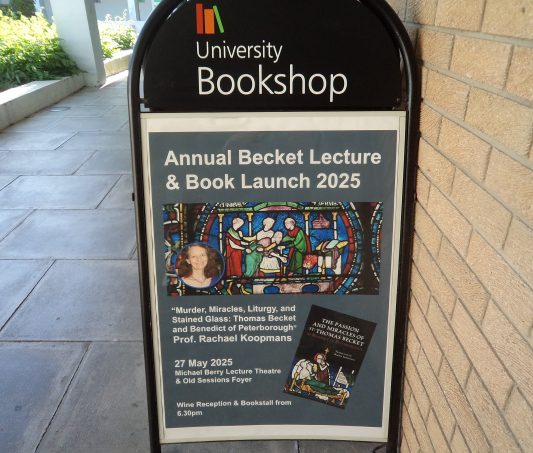
The 2025 Annual Becket Lecture will be on Tuesday 27 May at 7pm (wine reception from 6.30pm) in the Michael Berry Lecture Theatre, Old Sessions House, CCCU, Canterbury by Professor Rachel Koopmans. Her lecture is entitled ‘Murder, Miracles, Liturgy, and Stained Glass: Thomas Becket and Benedict of Peterborough’ and the Becket Lecture will be a book launch, provided by Craig Dadds at the CCCU Bookshop, for Rachel’s new edition of Benedict of Peterborough’s St Thomas miracle collection. Her book is entitled The Passion and Miracles of St Thomas Becket by Benedict of Peterborough, published by Boydell Press this month. It is the first English translation of Benedict’s remarkable (and very readable) work. The lecture is FREE and for more details see: https://ckhh.org.uk/events/details/annual-becket-lecture-2025 and we shall look forward to seeing you there. In addition, tomorrow (Tuesday 20 May) Nathalie Cohen will be speaking at CCCU at 3pm on ‘Pots, Palaces and Parks: Archaeology at the National Trust’. Her talk will be followed by a drinks and buffet reception at 4.15pm to celebrate the research conducted at the university in History, Archaeology and Heritage.
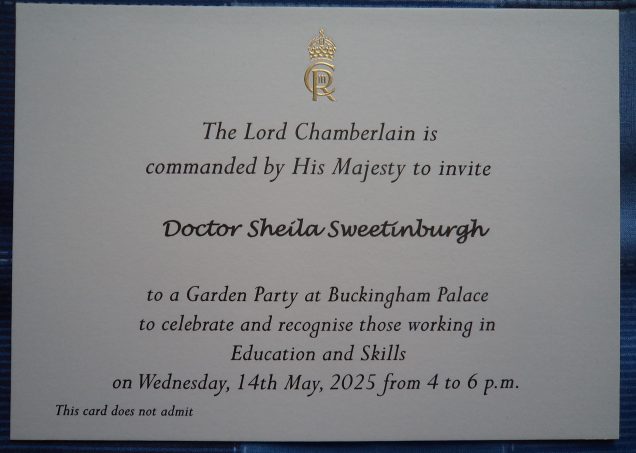
I have lots to get into this week’s blog and I thought it would be appropriate to start with the CKHH’s trip to a garden party at Buckingham Palace. The specific garden party I was invited to was ‘to celebrate and recognise those working in Education and Skills’ as you can see from the invitation. Therefore, it seemed highly appropriate to take Dr Claire Bartram as my guest because she is the other Co-Director of the Centre, for as they say, and adapting the verse from several of the Gospels, eg Luke 4:24, ‘own university’ could easily replace ‘own country’.
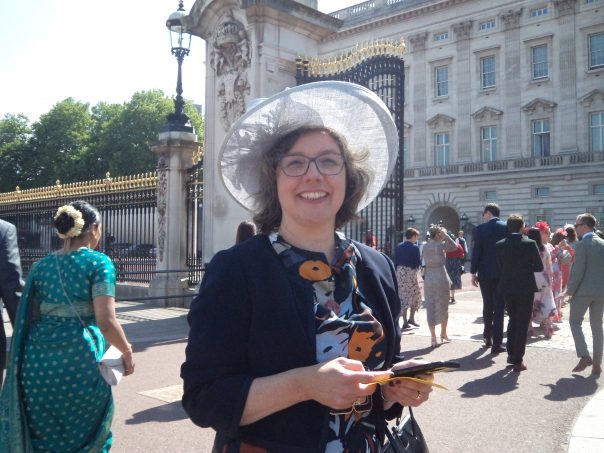
Indeed, bearing this verse in mind, it is great that CCCU students have the chance to nominate members of staff whom they feel have gone beyond what is generally expected. These Golden Apple Awards are an annual feature and it is gratifying to know that such efforts are recognised by students, if not by senior management. For being among the 14 staff in Humanities and Educational Studies receiving a Golden Apple, I thought I would share with you that I was nominated because “Dr Sheila Sweetinburgh … is one of the most dedicated, organised and down to earth people I have met. She is also very good at what she does.”
Now back to the garden party, on a very warm afternoon we joined the throng of guests eagerly waiting to be allowed into the grounds of Buckingham Palace and after the usual security checks that are necessary these days we were ushered through the forecourt and archway into the gardens behind the Palace. As you will see in the photos, Claire had gone for a hat with her smart outfit which meant she was in very good company because the display of hats would have delighted any self-respecting milliner, but I had declined such an idea (fortunately optional these days).
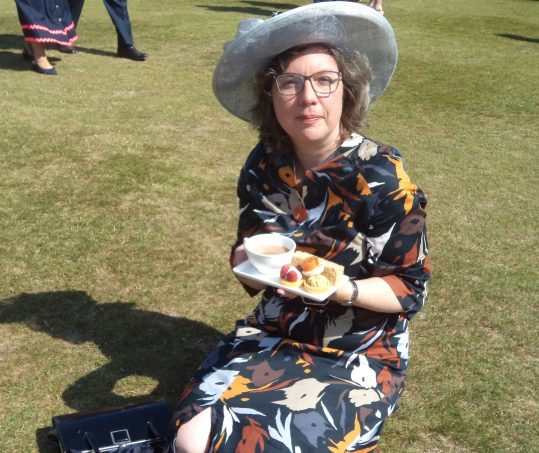
Having been provided with a plan of the gardens, lake, bands and various tea tents, we orientated ourselves before finding the shortest tea queue and therefore very quickly were in a position to sample His Majesty’s hospitality. It is very well organised and extremely good, comprising decent sandwiches and some splendid dainty cakes, including chocolate ones with the royal monograph. Consequently, we were fortified and then ready to join the back of the crowd that had formed up into two lines to watch the emergence from the terrace of the Yeoman of the Guard who ‘hold ground’ so that the royal party, in this case King Charles and Queen Camilla, can come down from the Palace and, having first met those chosen to be presented to them, they can meet other guests who are at the front of the crowd.
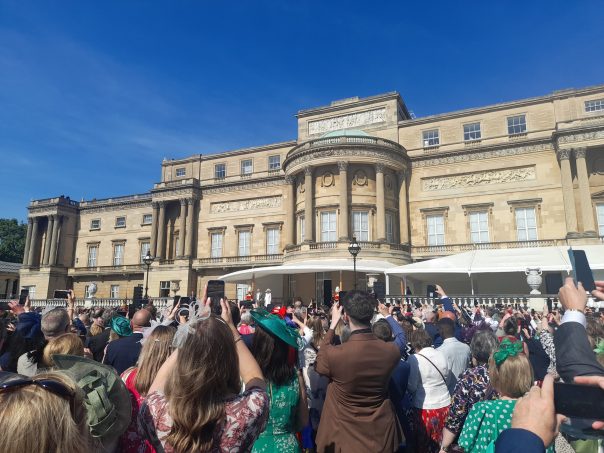
Having not opted for that approach, once the royal party were busy greeting guests, Claire and I headed for the shade to tour the gardens. As the gardens are run on good conservationist lines, the lawns are extremely parched due to the lack of rain this spring, but the trees being much deeper rooted are magnificent. In total the gardens comprise 40 acres, which means that they can accommodate diverse habitats, and the woodland areas not only have a range of tree species but lots of plants as ground cover and, as elsewhere, it seems everything in the Palace gardens has flowered early this spring too. Furthermore, the moorhens and coots are busy nesting on the 3-acre lake, while the Canada geese also looked very content, but I didn’t spot the great crested grebe.

However, I was very impressed by a couple of banks of foxgloves, as well as another of cornflowers and marigolds. We also had a good look at the wide range of roses in the Rose Garden as we circled round the gardens, and many of these too have flowered much earlier than usual, although the later varieties are still to come. On returning to the main lawn, we decided to investigate the tea tent again having been abstentious the first time and finding a place with no queue at all, we were able to again partake of royal hospitality. Indeed, we even found someone handing out ice creams – from a company based in the east end of London, which were excellent and very welcome.
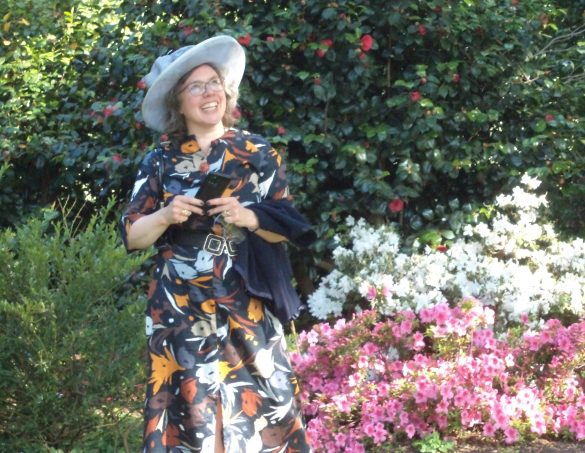
The finale of these garden parties is the return of the royal party from the Royal Tea Tent back to the Palace, the party again escorted by the Yeoman of the Guard that to a degree provides another chance for guests to meet those present. However, we didn’t opt for such a strategy and instead took a final turn around a small section of the garden before heading out through the Palace precincts and back into Buckingham Palace Road. Nevertheless, we felt it was an important occasion to have been part of and is testimony to the all the efforts of those involved with the Centre over the last decade – staff, students, partners, friends and our event audiences, as well as the value of such things as the Ian Coulson Memorial Postgraduate Award fund that has helped facilitate the study of about 20 postgraduates.
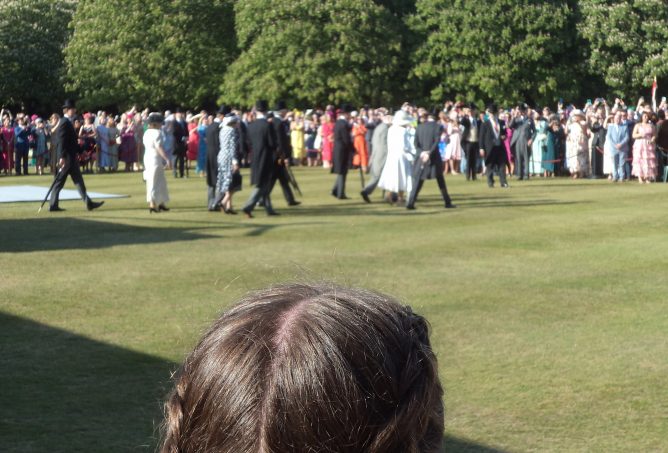
Now onto something that I did recently but hasn’t yet made it into the blog, albeit is indicative of the significance of the Centre’s role and activities locally and regionally. As a consequence of guiding a Canterbury Festival Walk last autumn, I was asked by Fr Eric Ohlund if I would give a group from the Association of International Churches in Europe and the Middle East (AICEME) a tour of Canterbury’s medieval churches as part of their conference in Canterbury and London. Consequently, having arranged access to St Peter’s and St Mildred’s (I didn’t think we would have time to include St Paul’s, and the group had already seen St Martin’s in the morning), we set off from the cathedral precincts, everyone having a handout comprising a map of Canterbury in 1500 showing the location of the churches, as well as illustrations of many of them. For very few survive as functioning churches which meant during the tour we looked at sites (the 4 High Street churches from St George’s to All Saints) and decommissioned churches (St Margaret’s that lost part of its east end to accommodate stage coaches turning into the Fountain Inn, renamed the Royal Fountain Hotel in the 19th century), as well as St Peter’s and St Mildred’s, as a means to understand the inter-relationships in medieval times between religious institutions and parishes, and between lay (and civic) society and the Church. Moreover, because we walked down Mercery Lane, passed Eastbridge Hospital and could see the Westgate, I added in ideas about pilgrims and pilgrimage which similarly generated a range of questions which is always a good sign!

Of course, the two churches are extremely interesting in different ways, and additionally St Mildred’s has the advantage of providing a range of surviving fabric from before the Norman Conquest to the early 16th century, and even the 19th century if you add in the material from the Gothic revival. This meant the pastors and their wives had a very enjoyable time learning about the churches’ development over time, looking at their structure and the fittings, such as at St Peter’s the entry to the now lost rood screen and the Easter Sepulchre and at St Mildred’s the choir stalls with their carved bench ends displaying the eagle of St John the Evangelist, the contemporary 15th-century font, as well as the magnificent slightly earlier nave crown post roof.
Finally, and keeping with the topic of religious history, the latest Canterbury Cathedral Chronicle arrived this week. Among its articles is one by Rachel Koopmans on the ‘Kent’ Becket Miracle Window nIV (part of the subject of her Becket Lecture) and another by me on St John’s hospital, probably the earliest medieval hospital foundation in England and one that still functions as an almshouse under the archbishop’s patronage.
 Centre for Kent History and Heritage
Centre for Kent History and Heritage Sheila Sweetinburgh
Sheila Sweetinburgh 1812
1812


Good to read that someone recognised your tremendous contribution. You also ought to receive the ‘Golden Tower’ for stepping out of the ivory tower of academia and sharing your expertise and knowledge with the wider public.
It is a great loss for Christchurch Canterbury.
Thanks very much, and great to put Canterbury (and Kent) on the map by giving them a national stage.
Splendid work yet again Sheila, an excellent update and thank you for the reminder of the Becket Lecture on the 27th at the Old Sessions House, much appreciated. Splendid photos of Claire who of course looks fabulous, but none of your good self I note. See you at the lecture.
Thanks for this, yes most definitely looking forward to Rachel’s lecture. Ah, that’s the advantage of being the author.
I’m delighted that you have been recognised by both the King and your students!
I’m also very sorry that Christ Church university is cutting back so hard on the areas that bring knowledge of our past
Thanks very much, and I agree but we are living in strange times!
Dear Sheila
In fact very dear and special Sheila, do I gather you will be leaving? Who ever could and will keep your important and valued department together and continually moving. This cannot be true.
With a plea to keep you as you have been for so many of us.
Philippa
Hello Philippa, sadly it is true and that’s the university’s decision, but who knows what the future will bring
Congratulations on the invite Shelia and so very well deserved. It looks like you had a lovely day and what fun and wonderful read that made. I love these blogs.
Thanks Paul, yes we did.